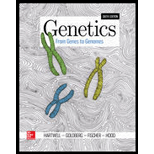
Concept explainers
a.
To determine:
The number of chromosomes in the plant with AABBC chromosome complement, the term that describes the plant’s genetic makeup, and whether the plant is fertile or sterile.
Introduction:
The condition that describes the cells containing only complete sets of chromosomes is referred to as euploid.
b.
To determine:
The number of chromosomes in the plant with BBBB chromosome complement, the term that describes the plant’s genetic makeup, and whether the plant is fertile or sterile.
Introduction:
Chromosome refers to a threadlike structure of DNA (deoxyribonucleic acid) found in the nucleus of the most living cells.
c.
To determine:
The number of chromosomes in the plant with CCC chromosome complement, the term that describes the plant’s genetic makeup, and whether the plant is fertile or sterile.
Introduction:
Chromosomes are the protein complexes or DNA that carry the genetic information from one generation to next in the form of genes.
d.
To determine:
The number of chromosomes in the plant with BBCC chromosome complement, the term that describes the plant’s genetic makeup, and whether the plant is fertile or sterile.
Introduction:
The complete set of chromosomes in the living cell are referred to as ploidy. The changes in the chromosome can be of two kinds: euploidy and aneuploidy.
e.
To determine:
The number of chromosomes in the plant with ABC chromosome complement, the term that describes the plant’s genetic makeup, and whether the plant is fertile or sterile.
Introduction:
A specific portion of DNA that serves as a unit of function by encoding a particular protein is known as a gene.
f.
To determine:
The number of chromosomes in the plant with AABBCC chromosome complement, the term that describes the plant’s genetic makeup, and whether the plant is fertile or sterile.
Introduction:
The plants that are able to produce seeds are known as fertile plants. The incapability of producing offspring is known as sterility.
Want to see the full answer?
Check out a sample textbook solution
Chapter 13 Solutions
Genetics: From Genes To Genomes (6th International Edition)
- Identify the indicated tissue? (stem x.s.) parenchyma collenchyma sclerenchyma ○ xylem ○ phloem none of thesearrow_forwardWhere did this structure originate from? (Salix branch root) epidermis cortex endodermis pericycle vascular cylinderarrow_forwardIdentify the indicated tissue. (Tilia stem x.s.) parenchyma collenchyma sclerenchyma xylem phloem none of thesearrow_forward
- Identify the indicated structure. (Cucurbita stem l.s.) pit lenticel stomate tendril none of thesearrow_forwardIdentify the specific cell? (Zebrina leaf peel) vessel element sieve element companion cell tracheid guard cell subsidiary cell none of thesearrow_forwardWhat type of cells flank the opening on either side? (leaf x.s.) vessel elements sieve elements companion cells tracheids guard cells none of thesearrow_forward
- What specific cell is indicated. (Cucurbita stem I.s.) vessel element sieve element O companion cell tracheid guard cell none of thesearrow_forwardWhat specific cell is indicated? (Aristolochia stem x.s.) vessel element sieve element ○ companion cell O O O O O tracheid O guard cell none of thesearrow_forwardIdentify the tissue. parenchyma collenchyma sclerenchyma ○ xylem O phloem O none of thesearrow_forward
- Please answer q3arrow_forwardRespond to the following in a minimum of 175 words: How might CRISPR-Cas 9 be used in research or, eventually, therapeutically in patients? What are some potential ethical issues associated with using this technology? Do the advantages of using this technology outweigh the disadvantages (or vice versa)? Explain your position.arrow_forwardYou are studying the effect of directional selection on body height in three populations (graphs a, b, and c below). (a) What is the selection differential? Show your calculation. (2 pts) (b) Which population has the highest narrow sense heritability for height? Explain your answer. (2 pts) (c) If you examined the offspring in the next generation in each population, which population would have the highest mean height? Why? (2 pts) (a) Midoffspring height (average height of offspring) Short Short Short Short (c) Short (b) Short Tall Short Tall Short Short Tall Midparent height (average height of Mean of population = 65 inches Mean of breading parents = 70 inches Mean of population = 65 inches Mean of breading parents = 70 inches Mean of population = 65 inches Mean of breading parents = 70 inchesarrow_forward
 Human Heredity: Principles and Issues (MindTap Co...BiologyISBN:9781305251052Author:Michael CummingsPublisher:Cengage Learning
Human Heredity: Principles and Issues (MindTap Co...BiologyISBN:9781305251052Author:Michael CummingsPublisher:Cengage Learning Human Biology (MindTap Course List)BiologyISBN:9781305112100Author:Cecie Starr, Beverly McMillanPublisher:Cengage Learning
Human Biology (MindTap Course List)BiologyISBN:9781305112100Author:Cecie Starr, Beverly McMillanPublisher:Cengage Learning Concepts of BiologyBiologyISBN:9781938168116Author:Samantha Fowler, Rebecca Roush, James WisePublisher:OpenStax College
Concepts of BiologyBiologyISBN:9781938168116Author:Samantha Fowler, Rebecca Roush, James WisePublisher:OpenStax College Biology: The Dynamic Science (MindTap Course List)BiologyISBN:9781305389892Author:Peter J. Russell, Paul E. Hertz, Beverly McMillanPublisher:Cengage Learning
Biology: The Dynamic Science (MindTap Course List)BiologyISBN:9781305389892Author:Peter J. Russell, Paul E. Hertz, Beverly McMillanPublisher:Cengage Learning Biology (MindTap Course List)BiologyISBN:9781337392938Author:Eldra Solomon, Charles Martin, Diana W. Martin, Linda R. BergPublisher:Cengage Learning
Biology (MindTap Course List)BiologyISBN:9781337392938Author:Eldra Solomon, Charles Martin, Diana W. Martin, Linda R. BergPublisher:Cengage Learning





